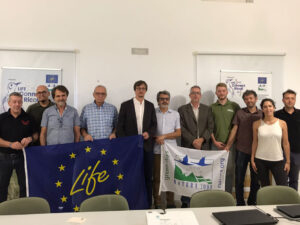The Life Connect Ricotí project aims to improve the conservation status of this endangered bird
In Catalonia, this species inhabit exclusively in areas of the Secans de Mas de Melons – Alfés
The Forest Science and Technology Center of Catalonia (CTFC) together with the Department of Climate Action, Food and Rural Agenda, and Catalan Forestry, participates in the European project LIFE Connect Ricotí, which aims to improve the conservation status of the Iberian population of Dupont’s lark (Chersophilus duponti), increasing its structural and functional connectivity, and acting on several key subpopulations.
The project, which was presented this Friday at Mas Melons, is coordinated by the Autonomous University of Madrid, and, in addition to Catalonia, the autonomous communities of Castilla-La Mancha and Castilla y León also participate.
 The director of Environmental Policies and Natural Environment, Marc Vilahur, explained during his presentation, that in Catalonia the project actions will focus on habitat restoration through planting actions, vegetation management and livestock management. All this will help to expand the potential habitat of the species, the ecological functionality and the connectivity of suitable habitats for Dupont’s lark and other steppe birds. At the same time, a recovery plan for the species will be drafted and approved to prevent its extinction in Catalonia, and to recover its population.
The director of Environmental Policies and Natural Environment, Marc Vilahur, explained during his presentation, that in Catalonia the project actions will focus on habitat restoration through planting actions, vegetation management and livestock management. All this will help to expand the potential habitat of the species, the ecological functionality and the connectivity of suitable habitats for Dupont’s lark and other steppe birds. At the same time, a recovery plan for the species will be drafted and approved to prevent its extinction in Catalonia, and to recover its population.
The work will begin in early October with actions in the Mas Melons estate, the Carrassumada wastelands and the Alfés area, the only place where Dupont’s lark can be found in Catalonia. Previously, the tasks of delimitation of the places where action should be taken have already been carried out and previous studies of habitat quality have been carried out to know the vegetation and availability of food in the area.
The CTFC provides knowledge and scientific experience in the design and evaluation of the effectiveness of some actions carried out in Catalonia but also in the other areas where this LIFE project is working. Specifically, it is in charge of evaluating the success of the translocations of specimens between populations that will be carried out in Castilla-La Mancha. For this reason, innovative technological tools are being implemented to monitor the birds, which have not been used in Spain until now.
An ambitious project

Alosa becuda, Chersophilus duponti
The LIFE Connect Ricotí project is the continuation of the LIFE Ricotí project, which focused exclusively on the Soria area. Now, taking advantage of the experience acquired in the management of the habitat, a more ambitious objective is proposed: to improve the connectivity of the populations of the Dupont’s lark through the management and restoration of quality habitats and the translocation of individuals, extending the area of action to Catalonia, Castilla-La Mancha and Castilla y León.
The project has a budget of 5.4 million euros, of which 3.9 million are provided by the European Union. The Catalan partners in the project, the Department of Climate Action, Food and Rural Agenda, Catalan Forestry and the CTFC, will spend 1.7 million euros, carrying out actions, mainly in Catalonia.
Dupont’s lark is a species listed as endangered in Spain and Catalonia. Its distribution area includes the Peninsula, the Maghreb (Morocco, Algeria and Tunisia) and the coastal strip of Libya and Egypt. In Spain, the distribution is fragmented and consists of scattered populations in areas generally of small size, which have been grouped into five major natural regions: Iberian System, Ebro Valley, Northern Plateau (Zamora and Central North), Southern Plateau and the southeastern peninsula. Its population has decreased from about 13,000 individuals at the end of the 1980s to about 7,000 in the years 2004-2007. Currently its population does not exceed 1,500 pairs, showing a strong decline in recent decades.
The population of the Dupont’s lark in Catalonia is limited to Alfés , where it was discovered in 1983. In the late 1980s and 1990s, it was considered that there were about 30-50 breeding pairs, but it was not until 2001 that standardized monitoring began, in less than 20 territories. Since then, it has been declining over the last two decades until becoming extinct in 2006. In 2015, it was detected again, and since then they have always been censused in less than 10 territories. Currently, with only two or three territories with males, it is surely one of the most endangered bird species in Catalonia.
Last modified: 15 September 2023










